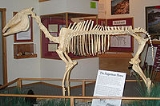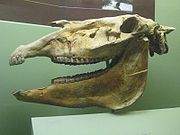
Hagerman Horse
Encyclopedia
The Hagerman horse also called the Hagerman zebra or the American zebra, was a North American
species of equid
from the Pliocene period
and the Pleistocene period
. It was one of the oldest horses of the genus Equus. Discovered in 1928 in Hagerman, Idaho
, it is believed to have been like the Grevy's zebra
of East Africa
. It is the state fossil of Idaho
.
 The Hagerman horse was given the scientific name of Plesippus shoshonensis in 1930 by a Smithsonian paleontologist named James W. Gidley who led the initial excavations at Hagerman that same year.
The Hagerman horse was given the scientific name of Plesippus shoshonensis in 1930 by a Smithsonian paleontologist named James W. Gidley who led the initial excavations at Hagerman that same year.
However further study by other paleontologists determined that fossils closely resembled fossils of a primitive horse from Texas named Equus simplicidens, named by paleontologist Edward Drinker Cope
in 1892. Because of this similarity, the two forms were interpreted to be the same species, and since the name Equus simplicidens was the older name, it was retained following the taxonomic Principle of Priority
. The Hagerman fossils represent the oldest widely-accepted remains of the genus Equus.
. Identified as bones belonging to an extinct horse, the area where the fossils were discovered, called the Hagerman Horse Quarry
, was excavated and three tons of specimens were sent back to the Smithsonian in Washington, D.C.
Excavation of the fossils continued into the early 1930s. The Hagerman Horse Quarry
floor grew to 5000 square feet (464.5 m²) with a backwall 45 feet (13.7 m) high. Ultimately five nearly complete skeletons, more than 100 skulls, and forty-eight lower jaws as well as numerous isolated bones were found. Some paleontologists believed that such a large amount of fossils found in one location was because of the quarry area being a watering hole at one point. The waterhole could have been where the bones of the Hagerman horses accumulated as injured, old, and ill animals, drawn to water, died there. It is now believed by most paleontologists that an entire herd of these animals probably drowned attempting to ford a flooded river and were swept away in the current and ended up buried in the soft sand at the bottom.

. It also was relatively stocky with a straight shoulder and thick neck, like a zebra, and a short, narrow, donkey-like skull. It is thought to have had a stiff, upright mane, ropy tail, medium-sized ears, striped legs, and some striping on the back.
The horse probably lived in grasslands and floodplains, which is what Hagerman was like 3 million years ago. Native North American horses went extinct about 10,000 years ago, at the same time as many other large-bodied species of the period.
North American
North American generally refers to an entity, people, group, or attribute of North America, especially of the United States and Canada together.-Culture:*North American English, a collective term used to describe American English and Canadian English...
species of equid
Equidae
Equidae is the taxonomic family of horses and related animals, including the extant horses, donkeys, and zebras, and many other species known only from fossils. All extant species are in the genus Equus...
from the Pliocene period
Pliocene
The Pliocene Epoch is the period in the geologic timescale that extends from 5.332 million to 2.588 million years before present. It is the second and youngest epoch of the Neogene Period in the Cenozoic Era. The Pliocene follows the Miocene Epoch and is followed by the Pleistocene Epoch...
and the Pleistocene period
Pleistocene
The Pleistocene is the epoch from 2,588,000 to 11,700 years BP that spans the world's recent period of repeated glaciations. The name pleistocene is derived from the Greek and ....
. It was one of the oldest horses of the genus Equus. Discovered in 1928 in Hagerman, Idaho
Hagerman, Idaho
Hagerman is a town in Gooding County, Idaho, United States. The population was 768 at the 2007 census.-Geography:Hagerman is located at .According to the United States Census Bureau, the city has a total area of , all of it land....
, it is believed to have been like the Grevy's zebra
Grevy's Zebra
The Grévy's zebra , also known as the Imperial zebra, is the largest extant wild equid and one of three species of zebra, the other two being the plains zebra and the mountain zebra. Named after Jules Grévy, it is the sole extant member of the subgenus Dolichohippus. The Grévy's zebra is found in...
of East Africa
East Africa
East Africa or Eastern Africa is the easterly region of the African continent, variably defined by geography or geopolitics. In the UN scheme of geographic regions, 19 territories constitute Eastern Africa:...
. It is the state fossil of Idaho
Idaho
Idaho is a state in the Rocky Mountain area of the United States. The state's largest city and capital is Boise. Residents are called "Idahoans". Idaho was admitted to the Union on July 3, 1890, as the 43rd state....
.
Classification

However further study by other paleontologists determined that fossils closely resembled fossils of a primitive horse from Texas named Equus simplicidens, named by paleontologist Edward Drinker Cope
Edward Drinker Cope
Edward Drinker Cope was an American paleontologist and comparative anatomist, as well as a noted herpetologist and ichthyologist. Born to a wealthy Quaker family, Cope distinguished himself as a child prodigy interested in science; he published his first scientific paper at the age of nineteen...
in 1892. Because of this similarity, the two forms were interpreted to be the same species, and since the name Equus simplicidens was the older name, it was retained following the taxonomic Principle of Priority
Principle of Priority
thumb|270px|Boa manditraIn zoology, the scientific study of animals, the Principle of Priority is one of the guiding principles of the International Code of Zoological Nomenclature, defined by Article 23....
. The Hagerman fossils represent the oldest widely-accepted remains of the genus Equus.
Discovery
A cattle rancher named Elmer Cook discovered some fossil bones on this land in Hagerman, Idaho. In 1928, he showed them to Dr. H.T. Stearns of the U.S. Geological Survey who then passed them on to Dr. James W. Gidley at the Smithsonian InstitutionSmithsonian Institution
The Smithsonian Institution is an educational and research institute and associated museum complex, administered and funded by the government of the United States and by funds from its endowment, contributions, and profits from its retail operations, concessions, licensing activities, and magazines...
. Identified as bones belonging to an extinct horse, the area where the fossils were discovered, called the Hagerman Horse Quarry
The Hagerman Horse Quarry
The Hagerman Horse Quarry is a paleontological site containing the largest concentration of Hagerman Horse fossils yet found. The quarry is within Hagerman Fossil Beds National Monument, located west of Hagerman, Idaho, USA, at the geographic division of the Snake River Plain...
, was excavated and three tons of specimens were sent back to the Smithsonian in Washington, D.C.
Excavation of the fossils continued into the early 1930s. The Hagerman Horse Quarry
The Hagerman Horse Quarry
The Hagerman Horse Quarry is a paleontological site containing the largest concentration of Hagerman Horse fossils yet found. The quarry is within Hagerman Fossil Beds National Monument, located west of Hagerman, Idaho, USA, at the geographic division of the Snake River Plain...
floor grew to 5000 square feet (464.5 m²) with a backwall 45 feet (13.7 m) high. Ultimately five nearly complete skeletons, more than 100 skulls, and forty-eight lower jaws as well as numerous isolated bones were found. Some paleontologists believed that such a large amount of fossils found in one location was because of the quarry area being a watering hole at one point. The waterhole could have been where the bones of the Hagerman horses accumulated as injured, old, and ill animals, drawn to water, died there. It is now believed by most paleontologists that an entire herd of these animals probably drowned attempting to ford a flooded river and were swept away in the current and ended up buried in the soft sand at the bottom.

Overview
The Hagerman horse first appeared about 3.5 million years ago. It was approximately 110-145 centimeters (43 to 57 inches) tall at the shoulder. It weighed between 110 and 385 kilograms (385 to 847 pounds). An average Hagerman Horse was about the same size as an Arabian horseArabian horse
The Arabian or Arab horse is a breed of horse that originated on the Arabian Peninsula. With a distinctive head shape and high tail carriage, the Arabian is one of the most easily recognizable horse breeds in the world. It is also one of the oldest breeds, with archaeological evidence of horses...
. It also was relatively stocky with a straight shoulder and thick neck, like a zebra, and a short, narrow, donkey-like skull. It is thought to have had a stiff, upright mane, ropy tail, medium-sized ears, striped legs, and some striping on the back.
The horse probably lived in grasslands and floodplains, which is what Hagerman was like 3 million years ago. Native North American horses went extinct about 10,000 years ago, at the same time as many other large-bodied species of the period.
Further reading
- Boss, N.H. Explorations for fossil horses in Idaho. Explorations and field work of the Smithsonian Institution in 1931. 1932.
- Gazin, C.L. A study of the fossil horse remains from the upper Pliocene of Idaho. Proceedings from the United States National Museum 83(2,985): 281-320. 1936.
- MacFadden, Bruce J. Fossil Horses. Systematics, Paleobiology and Evolution of the Family Equidae. Cambridge Univ. Press, 1992.
- McDonald, H. Gregory. More than Just Horses, Rocks and Minerals, Sept./Oct. 1993. Vol. 68:322-326.
- Willoughby, David P. The Empire of Equus. A.S. Barnes and Co. Inc., 1974
- Castle Rock Ranch-Hagerman Horse Quarry Land Exchange Environmental Assessment

